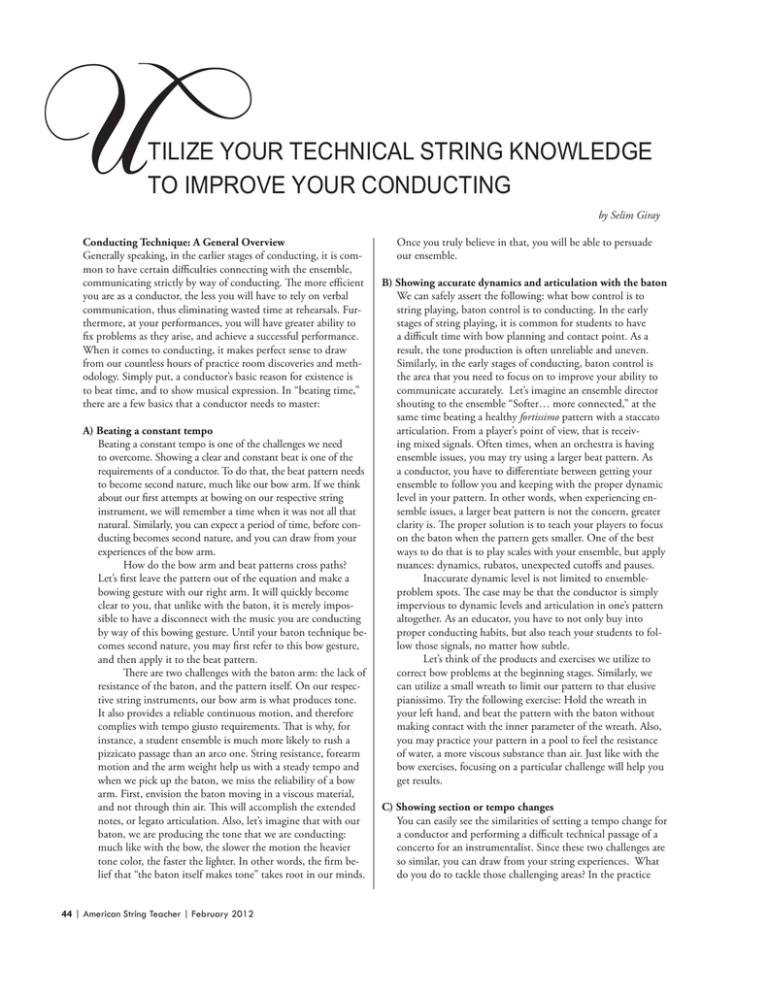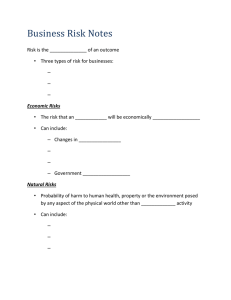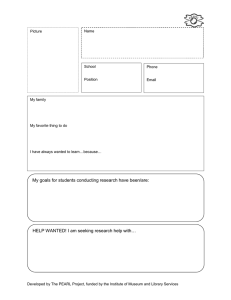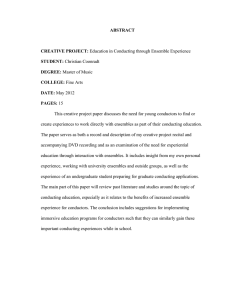TILIZE YOUR TECHNIC L STRING KNOWLEDGE TO IMPROVE
advertisement

by Selim Giray Conducting Technique: A General Overview Generally speaking, in the earlier stages of conducting, it is common to have certain difficulties connecting with the ensemble, communicating strictly by way of conducting. The more efficient you are as a conductor, the less you will have to rely on verbal communication, thus eliminating wasted time at rehearsals. Furthermore, at your performances, you will have greater ability to fix problems as they arise, and achieve a successful performance. When it comes to conducting, it makes perfect sense to draw from our countless hours of practice room discoveries and methodology. Simply put, a conductor’s basic reason for existence is to beat time, and to show musical expression. In “beating time,” there are a few basics that a conductor needs to master: A) Beating a constant tempo Beating a constant tempo is one of the challenges we need to overcome. Showing a clear and constant beat is one of the requirements of a conductor. To do that, the beat pattern needs to become second nature, much like our bow arm. If we think about our first attempts at bowing on our respective string instrument, we will remember a time when it was not all that natural. Similarly, you can expect a period of time, before conducting becomes second nature, and you can draw from your experiences of the bow arm. How do the bow arm and beat patterns cross paths? Let’s first leave the pattern out of the equation and make a bowing gesture with our right arm. It will quickly become clear to you, that unlike with the baton, it is merely impossible to have a disconnect with the music you are conducting by way of this bowing gesture. Until your baton technique becomes second nature, you may first refer to this bow gesture, and then apply it to the beat pattern. There are two challenges with the baton arm: the lack of resistance of the baton, and the pattern itself. On our respective string instruments, our bow arm is what produces tone. It also provides a reliable continuous motion, and therefore complies with tempo giusto requirements. That is why, for instance, a student ensemble is much more likely to rush a pizzicato passage than an arco one. String resistance, forearm motion and the arm weight help us with a steady tempo and when we pick up the baton, we miss the reliability of a bow arm. First, envision the baton moving in a viscous material, and not through thin air. This will accomplish the extended notes, or legato articulation. Also, let’s imagine that with our baton, we are producing the tone that we are conducting: much like with the bow, the slower the motion the heavier tone color, the faster the lighter. In other words, the firm belief that “the baton itself makes tone” takes root in our minds. Once you truly believe in that, you will be able to persuade our ensemble. B) Showing accurate dynamics and articulation with the baton We can safely assert the following: what bow control is to string playing, baton control is to conducting. In the early stages of string playing, it is common for students to have a difficult time with bow planning and contact point. As a result, the tone production is often unreliable and uneven. Similarly, in the early stages of conducting, baton control is the area that you need to focus on to improve your ability to communicate accurately. Let’s imagine an ensemble director shouting to the ensemble “Softer… more connected,” at the same time beating a healthy fortissimo pattern with a staccato articulation. From a player’s point of view, that is receiving mixed signals. Often times, when an orchestra is having ensemble issues, you may try using a larger beat pattern. As a conductor, you have to differentiate between getting your ensemble to follow you and keeping with the proper dynamic level in your pattern. In other words, when experiencing ensemble issues, a larger beat pattern is not the concern, greater clarity is. The proper solution is to teach your players to focus on the baton when the pattern gets smaller. One of the best ways to do that is to play scales with your ensemble, but apply nuances: dynamics, rubatos, unexpected cutoffs and pauses. Inaccurate dynamic level is not limited to ensembleproblem spots. The case may be that the conductor is simply impervious to dynamic levels and articulation in one’s pattern altogether. As an educator, you have to not only buy into proper conducting habits, but also teach your students to follow those signals, no matter how subtle. Let’s think of the products and exercises we utilize to correct bow problems at the beginning stages. Similarly, we can utilize a small wreath to limit our pattern to that elusive pianissimo. Try the following exercise: Hold the wreath in your left hand, and beat the pattern with the baton without making contact with the inner parameter of the wreath. Also, you may practice your pattern in a pool to feel the resistance of water, a more viscous substance than air. Just like with the bow exercises, focusing on a particular challenge will help you get results. C) Showing section or tempo changes You can easily see the similarities of setting a tempo change for a conductor and performing a difficult technical passage of a concerto for an instrumentalist. Since these two challenges are so similar, you can draw from your string experiences. What do you do to tackle those challenging areas? In the practice room, to get comfortable and efficient, we take them out of context and apply a multitude of our specific exercises. When we face complex passages, we simply remove those challenges layer by layer. That is, we remove all ornamentation, ties and bowings, and break down the excerpt to its most basic and simplest form. (See Figure 1) Let’s take a conducting challenge, a tempo change, and break it down and work on it in a methodical way. In the following excerpt, we will remove articulations, dynamics, rubatos or accelerandos, fermatas, caesuras, then reintroduce them one-by-one in our practice. For example, if we decide that the accelerando will go from MM 108 to 126, we will practice that with the help of the metronome. Then, we will make sure that our beat in all three metronome markings is accurate: from 108 to 126 in 4/4, and 78 in cut-time. Once we have the tempo accuracy, it is a simple procedure to reintroduce the other challenges: dynamics, articulation, fermatas. (See Figure 2) Parallels Between Bow and Baton Techniques Ball State University Professor of Conducting Leonard Atherton says in conducting, each beat consists of three parts: 1. A preparation 2. An ictus—the point at which the precise beginning of a beat is marked 3. A rebound1 As we know, the preparation of a bow stroke is essential in making good contact and the follow through after the stroke, and works much like the rebound after the ictus. If you consider retaking multiple triple-stop chords, you will quickly recognize how well the baton and the bow motions correspond. As novice string players struggle with this important portion of bow stroke, the preparation, less experienced conductors are likely to struggle with the same issue. For example, when the ensemble does not respond to the conductor’s prep, or takes a completely different tempo than the one the conductor had in mind, the culprit is inaccurate preparation. For conductors, good preparation for the segment of beat is achieved exactly the same way as the bow-stroke preparation, by breathing. If you breathe and synchronize your prep with the breath, you will have a consistent and accurate result, just like you would with the bow: the faster the beat the faster you breathe, the slower the tempo, the slower you breathe. Also, faster tempos are better executed with breathing through the mouth but not the nose—since we can breathe quicker with our mouth partly open. Translating String-Specific Terminology and the Daily Instrumental Practice Regimen Into the Craft of Conducting It is safe to say that a solid practice regimen is a bona fide survival tool for any string player. The technical work accomplishes two tasks: maintenance and improvement. The string player can only maintain and improve upon the technical ability through a trustworthy daily practice regimen. Why not adapt your string practice regimen into conducting? A reliable baton technique, clear cut-offs, and clear indication of tempo changes are elements that define a good conductor. As you depend on your bow technique and this difficult task has become second nature to you, the baton needs to come to the same proficiency level before you may truly rely on the right arm. First, to comfort ourselves, let’s imagine that the baton is our bow and forget about any pattern association and start conducting in the same manner that we would use a bow. Furthermore, let’s set aside the baton and create a bow grip. It will quickly become apparent that the two activities are actually quite similar, when we take the familiar approach. With our bow, we have the prepatory motion, the playing motion and the follow through. The same is the case with conducting: the prepatory portion of the beat, the beat itself (or ictus) and rebound. In the string performance, to internalize the upcoming piece of music, you breathe along with the prepatory motion. To provide a good prep, you should never lose your focus of breathing. Bowings Associated With Various Articulations Détaché: Not legato nor marked, a simple pattern. We avoid any unintentional marking or accents (especially on the strong beats). Legato: Giving extra attention to connecting between notes. When conducting, we need to move our right arm with the smoothest motion possible. Closely related to legato playing is the concern of sustaining. Sostenuto playing will be achieved by a legato conducting with the help of the left hand, as it is in crescendo. Portato or louré: Slight separation between notes. In conducting, slight wrist movement combined with legato arm movement. Spiccato: Less forearm, more wrist movement is needed. Martélé: Marked notes are achieved by a decisive forearm motion, just like with the bow. Staccato: Good separation between notes. Much like marcato, except without the accent. Artificial spiccato (or slow spiccato): After the initial attack, forearm motion continues through the slow beat. It is quite apparent that proper conducting and bowing motions are very similar, if not the same. This is an immense advantage for string players. So, in the same way you work on those bow strokes, we will work on different beat patterns and articulations in numerous metronome markings. Sample Practice Regimen The main goal in any practice regimen is eliminating bad habits while reinforcing the good ones. Also, just like it is with string instrument exercises, use of a mirror and a video camera is highly recommended. Breathing and stretching exercises: Since conducting involves breathing and utilization of our entire body, it is highly recommended to precede your practice with breathing and stretching exercises. An activity like yoga would address three important areas: breathing, stretching and meditating. Creating good posture: As it is with string playing, posture is the basis of a solid conducting technique. Right arm exercises: Conduct an exercise from Phillips, McElheran or any other standard textbook. Repeat with both arms. Left hand exercises: Sing a Bach chorale, or any hymn from a hymnal, while utilizing the left hand. Make sure to use the left hand when needed. For expressive purposes, entries and cutoffs only—no pattern. Repeat with both arms. Study and perform your repertoire as a conductor in a performance, not as a “teacher” but solely as a conductor. On weekends and teacher work days: Take up a new “challenge” such as a standard composition, whether you are likely to conduct it or not. Study and prepare the score, and practice conducting. Utilize this time to improve on your skills and find new and more difficult challenges. Scale Exercises, Trust and Communicating With Our Ensemble • Avoiding student “auto pilot” susceptibilies with scale exercises. It is an established practice to start a rehearsal with scales, especially in elementary and secondary education. It is among the most efficient ways of teaching your ensemble to follow you, and work on your clarity of conducting gestures. Let’s take a rote two octave G major scale. You will have a score: Quarter note equals MM 60 in common time using one note per bow. Crescendo through the ascending portion of the scale, comma without a pause, and decrescendo through the descending portion of the scale. Then, add a second layer of difficulty. Alter the tempo with specific accelerandos and rubatos, and then change the comma with a caesura, with an extra prep. Next, replace the caesura with a fermata. Afterward, change the placement of the commas, caesuras and fermatas. Start your rehearsals with these exercises every day, all the while increasing the difficulty level both for yourself and for your ensemble. Use cutoffs and pauses on weak beats, show accents on unexpected weak beats, and show different articulations. Introduce different meters, including the compound and uneven meters. All of these variables will reveal your entire conducting vocabulary to your ensemble, and improve trust. Furthermore, you can utilize any exercise from your conducting classes or lessons. Using the Left Hand For Demonstrating Expression Left-hand technique for string instruments can be summarized by the following: scales and arpeggios, shifting, double-stops, trills and vibrato. We utilize our left hand both for technical and expressive functions. Similarly, in conducting, our left hand is used for both for technical and expressive means. In short, we need the appropriate use of the left hand in all technical and musical communication: cutoffs, entrances, and help with dynamics. When you think about what the left hand is capable of, it becomes apparent what a waste it is to revert to the dreaded mirroring. In reality, mirroring does not enhance your right hand, but simply ties up your ability to communicate more effectively. Also, the overuse of mirroring is much like crying wolf: in order for your ensemble not to be desensitized, you have to extremely limit its use. If you truly limit yourself to mirroring only in the case of considerable accelerandos or rubatos, then you will get the most attention with this gesture. Furthermore, given the fact that you are already accustomed to be expressive with your left hand—as in vibrato and portamento—you will truly appreciate the endless possibilities that your left hand provides on the podium. General Strategies in Improving Our Skills as a Conductor Guest conduct non-string ensembles: band and choir. It is an effective strategy to put yourself in an unfamiliar environment, such as conducting a musical, to improve your conducting skills. Record your rehearsal. Open the sound file in a music editing program, where you can distinguish between music and speech in the graphic form and compare the two by percentage. How well did you do? Can you challenge yourself to decrease the amount of speech for the next rehearsal? Ask a colleague to help with “role playing” and conduct. Role playing is an exercise that conducting instructors utilize: While the student is conducting, the teacher sings. However, when asking your colleague to do this role playing exercise, you can ask him or her to perform as your students would. Rush the technical passages, drag the cantabile ones, and hesitate to come in at the scary entrances. How well do you react? Sight-reading sessions with your ensemble. It is a great challenge to sight-read with your ensemble. However, it is a greater challenge to sight-read in front of an ensemble that knows the work. How about sight-reading with your colleague’s ensemble, close to its performance date? It is a wonderful way to test your ability to think on your feet, and to prove your communication skills in conducting. It is an invaluable strategy to think about the parallels between the craft of string playing and conducting. It is apparent that none of us has unlocked the secrets of string instruments overnight, and without challenges. However, as our relentless training proved successful as string players, our knowledge and determination will prove successful once again in conducting. We will improve our skills and serve our students as best we can. Endnotes 1 Leonard Atherton, Vertical Plane Focal Point Conducting (Muncie: Ball State University, 1989), 3. Bibliography Atherton, Leonard. Vertical Plane Focal Point Conducting. Muncie: Ball State University, 1989. Bowen, José Antonio, editor. The Cambridge Companion to Conducting. Cambridge: Cambridge University Press, 2003. Braithwaite, Warwick. The Conductor’s Art. London: Williams and Norgate, 1952. Farberman, Harold. The Art of Conducting Technique: A New Perspective. Miami: Warner, 1997. Gehrkens, Karl W. Essentials in Conducting. Boston: Oliver Ditson, 1919. Green, Elizabeth A. H. The Modern Conductor. Englewood Cliffs: Prentice-Hall, 1981. Grosbayne, Benjamin. Techniques of Modern Orchestral Conducting. Cambridge: Harvard University Press, 1956. Linton, Stanley. Conducting Fundamentals. Englewood Cliffs: Prentice-Hall, 1982. McElheran, Brock. Conducting Technique: For Beginners and Professionals. New York: Oxford University Press, 1966. Phillips, Kenneth H. Basic Techniques of Conducting. New York: Oxford University Press, 1997. Rudolf, Max. The Grammar of Conducting: A Practical Study of Modern Baton Technique. New York: Schirmer, 1950. Saito, Hideo. The Saito Conducting Method. Edited by Wayne J Toews; translated by Fumihiko Torigai. Tokyo: Min-On Concert Association, 1988. Scherchen, Hermann. Handbook of Conducting. Translated by Michel Dimitri Calvorcoressi. London: Oxford University, 1933.





